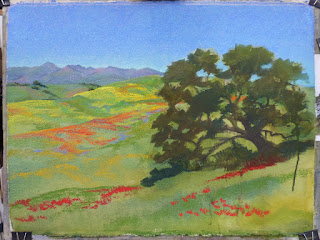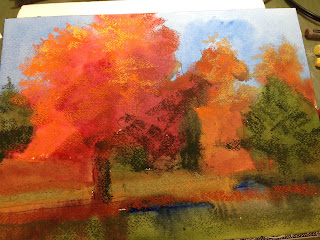We covered quite a lot in class today - thanks to all of you for your hard work, attention, and enthusiasm! There is a lot of information in the blog today, so grab a cup of coffee or a glass of wine and kick back.
Here is the subject for this coming week - please come to class with this image drawn in pencil on your watercolor paper. This is a more complex composition so we will need to get right to work and save the critique for last. As always, give this a try if you would like to come to class with your own questions.
Here is the black and white reference for seeing the values clearly.
If you would like to try painting glass
and flowers together, here's an image that will challenge you for sure (and make you wish you owned 1,000 pastels)! Remember, think in values, and cool - vs- warm....and of course, DETAILS LAST!! If you want a simpler challenge, zoom in on just one or two flowers.
We had fun painting this simple glass bottle placed on a lovely linen.
First the watercolor under painting of large color shapes (no detail) in dark, neutralized colors.
Pastel was added to enhance the patterns of the fine linen tablecloth, the sheen of the table and of course the glass bottle. As you can see, drafting skills are important....sadly, the bottle neck appears quite off kilter in my painting. Take time to examine your drawing in a mirror to save yourself this problem. There are 3 things make us humans assume we are seeing a glass object; the sparkle (highlight) the squiggle (distortions in the glass) and painting the background right through the glass shape.
We reviewed the process of a commissioned painting I just finished:
I did the initial drawing on 300# Arches with a hard, mid value pastel as it would be easy to erase if the drawing wasn't accurate.
I then redrew the image with a firm pencil line that would be visible after the watercolor was applied.
I washed in the blue sky, lavender hills, tree and grasses working from top to bottom and from cool to warm. In this image I have also begun to suggest the branch structure of the live oak tree.
I alternately stroked on cobalt blue, green blue, and blue violet pastels to suggest the brilliant blue California sky. I also began to introduce pastels to the distant rolling hills indicating great swaths of poppies and grasses.
I was struggling to make the tree colors dark and dense enough so I painted the dark brown and green pastels with clear water so they would melt into the paper - thereby filling the tooth of the paper with a dark, dense under painting.
I added pastels to the tree and began to indicate the poppies and grasses in the foreground.
I added more sky holes and bits of the distant poppy fields to make the tree appear more airy. I also broke up the too even rhythm of the undulating hills by joining the two nearest hills into one larger shape.

The foreground poppies lacked punch because the green under painting was showing through the red flowers and neutralizing them. So, once again I used clear water to turn the red pastel into an under painting. After the poppy shapes were dry I was able to add real brightness to the flower clusters.
Here is a close up of the newly under painted poppies.
Here is the finished painting "Lyrical Live Oak in a Sea of California Poppies"









































